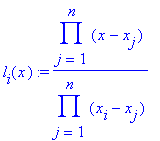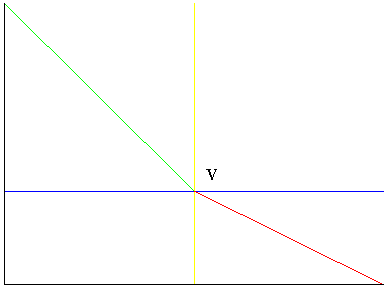Special Problems
How to Write These Up: Carefully! That
is: use those helper words: Let, so, but, thus, so we know, now we prove, we
must show, it thus follows from, etc. REMEMBER: you are to take the
position that you have discovered something and are tell me (an intelligent
reader!) what the solution is. But, I'm not clairvoyant, so you need to
work hard and write carefully so that I can understand your argument. NOTE:
I've renumbered these.
SP #1: This problem is motivated by the Paint Paradox: Recall, in that
problem, that one of the steps was to show that the area under y=1/x from 1 to
infinity was infinite. This problem asks you to figure out what happens
when y=1/x is replaced by y=1/x^r for various r real numbers r. [Of
course, r is the exponent of x, using the convention that "^" means
"raise to."] Specifically, show the following:
Theorem: Let y=1/x^r, where r is a real number. Then
(a) If r > 1, then the area under y=1/x^r from 1 to
infinity is finite. [Actually find this area in terms of r.]
(b) If r < 1, then the area under y=1/x^r from 1
to infinity is infinite.
COMMENTS:
(1) Of course, by the area from 1 to infinity, one means the limit as t
approaches infinity of the area from 1 to t.
(2) We will see an application of this theorem when we do Chapter 11,
Infinite Series. There is a test, called the Integral Test, that uses
this result.
SP #2: I forgot. Maybe it was to prove the reduction formula #74 at the
back of the book.
SP# 3: In the proof of Theorem B in the section on numerical integration, we
were trying to show that f(b)=f(a)+f '(a)(b-a)+f ''(c)/2 [b-a]^2 for some c in (a,b).
To this end, we defined L by the equation: f(b)=f(a)+f '(a)(b-a)+L[b-a]^2 and
defined p(t)=f(b)-f(t)-f '(t)(b-t)-f ''(c)/2 [b-t]^2. In SP #2, you are
to:
(a) Show p(a)=0
(b) Show p(b)=0
(c) Use the Mean Value Theorem applied to p(t) and (a)
and (b) above to find L.
SP #4: Show Theorem B + Theorem C implies Theorem A of the numerical
integration section. Hint: Write f(x)=f(a)+f '(a)(x-a)+f ''(c(x))/2
[x-a]^2 (which follows is just Theorem B), and integrate this from a to b and
then use Theorem C to help evaluate one of the integrals you get.
SP #5: In the Gaussian Quadrature section, let (x1, y1),
(x2, y2), .... (xn, yn) be points in
the plane with the xi's all disctinct real numbers. Define li(x)
as the product below, where the products are taken over all j except
j=i.
Notice that each li(x) is a polynomial in x of degree n-1.

A. Show li(xj)= 1 if i=j and 0 otherwise
B. Set P(x) = y1l1(x) + ... + ynln(x).
Show P(x) is a polynomial of degree < n-1 which passes through each
of the n points (x1, y1), (x2, y2),
.... (xn, yn).
C. Show that if Q(x) is any other polynomial of degree <
n-1 passing through these
same n points, then P(x)=Q(x), so that P(x) is the UNIQUE polynomial of degree
< n-1 passing
through these n points. [HINT: you'll need the result that a polynomial of
degree n has at most n roots. Also, recall, we said in class that a
polynomial of degree n with complex (or real) coefficients has exactly n
roots, if they are counted "properly." MORE HINT: Let H(x)=P(x)-Q(x)
and show H(x)=0 by showing it has more roots than it "should."]
D. If n=2, show that P(x) becomes the following two-point formula for
the equation of a line:

SP #6 [Thanks to Victor]. How can Simpson's rule give the exact answer
for lines (it is actually supposed to give the exact answer for cubic and
lower degree polynomials) when it approximates functions by parabolas and a line
is straight? Suggestion: Look at the line y=mx and the interval [a,b].
Find the parabola passing through the three points [a,ma], [(a+b)/2), m(a+b)/2],
and [b, mb] and discover why the area under this parabola is indeed the area
under the line [from x=a to x=b].
SP #7 Open that Maple worksheet [that I e-mailed you already] called gauss.mws
[you may have to SHIFT-CLICK to let you save it to disk] and
use it to look at the roots various different Legrendre polynomials, and make
then some guesses (conjectures) about the location (distribution) of these
roots.
SP #8A Snell's Law. In the picture below, show that the value of x that
minimizes the time for an object to travel from point P to point Q such
that

where a1 and
a2
are
the angles between the vertical yellow line and the green and red lines,
respectively, and v1 and v2 are the velocities above and
below the blue line, respectively.
P

x
Q
HINT: Find, in terms of x, the the total time to travel from P to Q through V
by finding (in terms of x), the time to travel from P to V and adding to that
the time to travel from V to Q. Call that function T(x). Then use calculus
to find a condition for T(x) to be a minimum. When you do, out will pop
Snell's Law.
SP #8B: [The Brachistochrone Problem: This is the end of the argument that a
bead sliding down a frictionless wire from a point (0,H) does so in minimal time
when the shape of the curve it is sliding down is a cycloid.
We had derived a differential equation for y=f(x), the equation of this path
of least time and found that:
 for some constant K.
for some constant K.
In this problem, you will integrate this expression and then
recognize it (somehow) as a cycloid).
A. First, integrate both sides, getting

and then make two changes of variables: First, set v=H-y and
then set
tan (f)
= sqrt(v/(K-v). [You'll need to show that v = K sin2 (f)
to find dv.]
B. Then do the integral [it will be one with respect to f.]
you get and show
K(f
- (1/2) sin 2f)
= -x + C1, where C1 is another constant.
C. Use the fact that tan (f)
= sqrt(v/(K-v), and v=H-y and the fact that the curve passes through the point
(0,H) to show that the constant C1 equals 0.
D. Use the fact that v = K sin2 (f)
and v=H-y to show y=H-(K/2)[1-cos 2(f)]
E. Replace (2f)
with q
to conclude (show why) that a parametric equation for the curve we are looking
for is
x = L (q
- sin(q))
and
y= H - L (1 - cos(q
)), for some constant L >0.
F. Show why THAT is indeed a cycloid. [You'll need
to understand what the "H" is doing in the equation for y and what
that minus sign is doing there.] HINT: Do an example to see what is
going on here. Specifically, you know that
x = t
y = t2
is a parabola. Now graph
x = t
y = 3 - t2
and see what happens.
SP #9: Consider the circle in polar form r=2cos(q)
and show that the slope of the tangent line to this curve at the point (r,q,)
as computed by the formula on page 665 gives the same result as when one first
finds the slope of line joining the center of the circle, (1,0), with the the
point (r,q)
[you'll need to change this to rectangular coordinates to find that slope] and
then taking the negative reciprocal of that slope.
SP #10: Assume we have n
vectors · in n-space which
satisfy:
(1) vi ·
vi= 1 for i=1,...n..
(2) vi ·
vj
= 0 if i does not equal j.
[Recall that this
means that the vectors v1, ... ,vn are
a "coordinate system," in that each has unit length and that are
perpendicular. Recall, further, that the "dot" product of two
vectors is the sum of the products of their coordinates. That is:
(u1, ..., un) ·
(v1, ..., vn) = u1v1+... +unvn
]
Now, let F=(x1,
..., xn) be any vector in n-space.
Show: F=
(F ·
v1)v1 +(F·
v2)v2.... + (F ·
vn)vn
NOTE: Recall the
following definitions of vector addition and
scalar multiplication.
(a) (u1,
..., un) + (v1, ..., vn) = (u1+v1,
..., un+vn)
(b) K (u1,
..., un) = (Ku1, ..., Kun), for any
constant (scalar) K.
NOTE: What this
problem does is to give a formula for the coordinates of a vector F with
respect to a new coordinate system.
SUGGESTION: Do
the case n=2 first.
RECALL: We needed this
result to find the components of gravity in the r-direction and the
theta-direction. Here is the Maple worksheet that used this idea:
kepler_for_class.mws.
HINTS:
A. You may find
useful the following properties of dot product. You may simply use them
but it would be better if you were to prove them:
(1) If u, v and w are
vectors in n-space, then u·(v+w)
= u·v
+ u·w
(2) If u and v are
vectors in n-space and K is a number, then u·(Kv)
= K (u·v)
(3) If u is a vector
in n-space and if v1, ... ,vn are as in
this problem and
if u·vi
= 0 for i=1, 2, ..., n, then u = 0.
[Comment: (1) and
(2) are easy to prove but (3) is not so easy. The proof of (3) is
usually given in a linear algebra class such as Math 203 or 322 (or 321?)]
B. This problem
really approached two ways:
(1) A PARTIAL
SOLUTION: Show that if F = c1v1
+c2v2.... + cnvn then ci=F·
vi for each i. [This part is "straightforward" and does
not use Hint A (3), above.] [The point is that we actually have no a
priori reason to thing that F is a combination of the vi's, but
if we assume it is, then it is not so hard to find out those coefficients, ci.
(2) A FULL SOLUTION:
Show that
F - [
(F ·
v1)v1 +(F·
v2)v2.... + (F ·
vn)vn ]=0 by a direct application of Hint A (3)
above.
SP #11: Let f(x)
be a function.
Assume there exists a
constant, L, such that for all real number a and b, we have:

Show:
f(x) = L (that is, that f(x) is the constant function L)
HINT:
Apply the hypothesis with a=a and b=t, with t a variable. The
differentiate both sides and use the Fundamental Theorem of Calculus.
NOTE:
Of course, the converse is true: if f(x) does = L, then that integral
formula is certainly true.
NOTE:
We needed this fact to show that r(t)2 dq/dt
is constant and we needed THIS to show that the q-component
of gravity (below) equals 0, and THIS was the case because the derivate
of r(t)2 dq/dt
had to be 0 (since it is constant) and this derivative is this q-component
of gravity time r(t), but r(t) is not zero so the q-component
of gravity is zero (whew!!).







